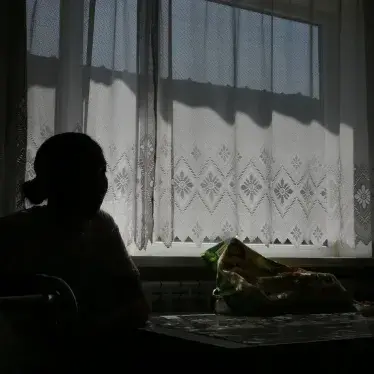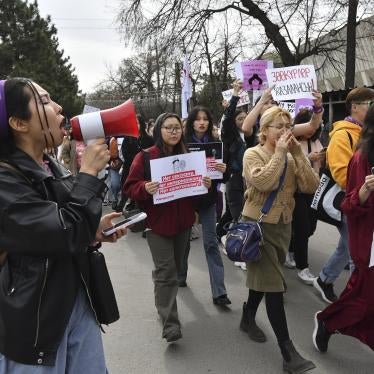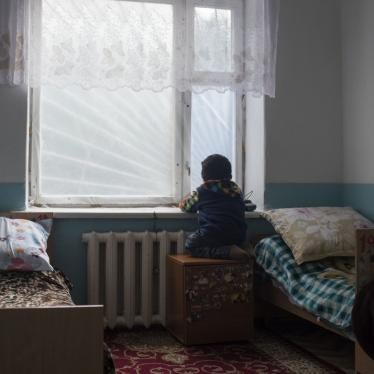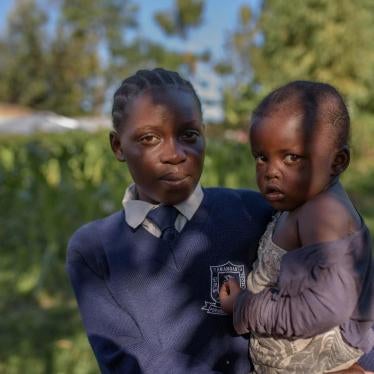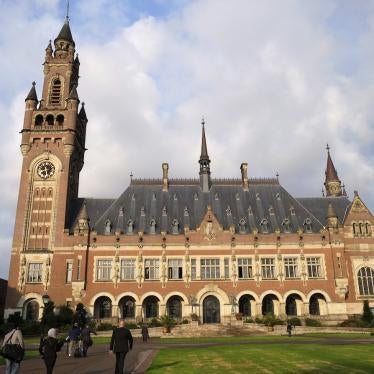We write in advance of the 94th Pre-session of the Committee on the Rights of the Child (“the committee”) and its review of Kyrgyzstan to highlight areas of concern regarding the government of Kyrgyzstan’s compliance with the Convention on the Rights of the Child (CRC). This submission addresses articles 2, 19, 24, and 28 of the Convention. The submission covers violence against girls, abduction of girls and women for child and/or forced marriage, access to education during the Covid-19 pandemic, protection of education from attack, and barriers to education for children with disabilities.
Violence Against Girls (article 19)
Human Rights Watch notes the steps that the government of Kyrgyzstan has taken to prevent violence against women and girls since the Kyrgyz government presented its last report before the committee. In 2016, the government introduced criminal penalties for those who conduct or facilitate religious marriages of children; in 2017, it adopted a strengthened Law on Prevention and Protection Against Family Violence (Family Violence Law) which requires police to respond to every domestic violence report and issue a protection order; and in 2019, the government criminalized domestic violence, abduction for the purpose of marriage, or “bride kidnapping,” and forced marriage. In March 2020, parliament adopted amendments to domestic violence related laws which include provisions to hold relevant law enforcement officials to account for failure to adequately implement the law.[1] The Ministry of Health and Ministry of Internal Affairs issued internal instructions on the application of the law, and in 2021 the government embarked on development of a new gender equality strategy for 2022-2030 and a national plan of action for 2021-2023.[2] In February 2021, the first state-run crisis center with shelter space for 60 women with children affected by domestic violence was opened.[3]
Despite a strengthened legal and policy framework, domestic violence remains a pervasive problem in Kyrgyzstan and significant gaps in protection of women and girls persist. In addition, the Kyrgyz government is doing little to increase the number of shelter spaces or access to medical, mental health and psychosocial support, legal and socio-economic services for domestic violence survivors, or to ensure investigation and prosecution of cases.[4]
The gaps in Kyrgyzstan’s domestic violence response were recognized at parliament in January 2020, after at least three women died after being severely beaten by their partners.[5] Additionally, government data shows that from January to March 2020, law enforcement agencies in Kyrgyzstan registered 2,319 complaints of domestic violence.[6] And according to the Kyrgyz National Statistic Committee, in 2021, the police registered 8,587 cases of domestic violence against women.[7]
Risk to women and girls of violence in the home increased around the globe during the Covid-19 pandemic, exacerbated in some cases by public health measures such as lockdowns.[8] On March 22, 2020, the Kyrgyz government introduced a state of emergency, including restrictions on freedom of movement and a curfew, which contributed to women and girls experiencing or at risk of domestic violence being unable to escape their aggressors.[9] Within the first six months of 2020, the Ministry of Interior Affairs reported a 65 percent rise in the number of domestic violence cases compared to the same period in 2019.[10]
Due to the state of emergency, shelters, crisis centers, and other services were closed and not allowed to accept new cases, leaving domestic violence survivors with nowhere to turn.
Human Rights Watch has documented how poor police and judicial response, the lack of services such as shelters, and social pressure by families and authorities inhibit victims from coming forward to report abuse.
Protection Orders and Police Response to Domestic Violence
The 2017 Family Violence Law led to a notable spike in protection orders, intended to provide short-term, immediate protection from abuse. The Ministry of Internal Affairs reported that in the first six months of 2022, temporary protection orders were issued to 4,421 victims of domestic violence, of which 55 were boys and 64 girls.[11] And in the same period, 6 protocols were drawn up for failure to comply with the conditions of a temporary protection order; 3 were arrested.[12]
Service providers and activists told Human Rights Watch that while police are issuing more protection orders under the new law, they still do not issue them in every case, and violations of the orders are rarely punished. The head of the Association of Crisis Centers has also pointed out that the issuance of protection orders alone is inadequate: “If the perpetrator is an abuser used to resorting to domestic violence regularly, for him a three-day protection order is nothing.”[13]
Police and Judicial Response to Complaints of Domestic Violence
Although service providers said police are more likely to accept complaints than in the past, these generally stall unless victims are accompanied by a lawyer or crisis center worker. “A complaint might be registered, but it won’t go any further,” an Osh crisis center staff member said.[14] Yet legal assistance remains difficult to access or is non-existent.
Countering dismissive attitudes and inaction by police is an ongoing battle, activists say. An Osh crisis center director cited a case in which medical workers alerted authorities about four pregnant girls, all of them in religious marriages, which are not registered with the state and therefore exclude spouses from legal protections. Ultimately, she said, no one was prosecuted.
Kyrgyzstan’s State Agency for Local Government, as well as the ministries for internal affairs, social development, justice, and health, have an essential role to play in implementing national commitments and focusing local officials’ attention on domestic violence.[15]
Since the Family Violence Law was adopted in 2017, the government has yet to fulfill the law’s requirement to designate a body to oversee domestic violence prevention and protection activities, due in part to disagreement on responsibilities of government agencies. The body’s responsibilities include conducting research, collecting and analyzing data, and coordinating correctional programs for abusers.[16] A consequence of this has been ministries using different iterations of the law as the basis for data collection resulting in inconsistent statistics on the number of cases registered.
In 2022, the Ministry of Labour and Social Welfare developed a guidebook for local government committees on protection from domestic violence, as part of the Spotlight Initiative.[17]
Human Rights Watch recommends that the Committee ask the government of Kyrgyzstan:
- How many domestic violence cases registered by police have involved children, and specifically girls, including forced and early marriage and so-called “bride kidnapping”? How many such cases resulted in investigations, prosecutions or convictions of alleged perpetrators?
- How many of the protection orders issued were in response to concerns about children who witness or experience domestic violence? How many of the protection orders ended up with charges and punishment for not being observed by perpetrators?
- What measures is the government taking to enforce the law regarding religious marriages of children and to hold those who conduct or are otherwise responsible for such marriages to account?
- What measures is the government taking to ensure access to legal, medical, and social services for children who experience or witness domestic violence?
- What measures is the government taking to train police officers and judges in responding to domestic violence cases, including specifically with regards to handling cases involving children?
Human Rights Watch recommends the Committee to use the upcoming review to urge the government of Kyrgyzstan to:
- Ensure that women, children of all ages and genders, and women with children subject to or at risk of domestic violence, have full access to essential services, including short-term and long-term shelters, medical care, psychosocial support, and legal assistance, including in rural areas.
- Ensure that all relevant personnel–including in the health, law enforcement, and judicial sectors–participate in mandatory training on appropriate responses to domestic violence at regular intervals and in accordance with international best practice standards on a survivor-centered response.
- Ensure that law enforcement personnel effectively initiate, enforce, and monitor protection orders, and those who inadequately respond to domestic violence complaints are held accountable for misconduct.
- Ensure that staff at both government and NGO-run crisis centers undergo mandatory and ongoing training to enable them to provide services and support for survivors, including children, while respecting their rights and dignity and protecting their safety.
- Take measures to raise public awareness regarding domestic violence, available services, and how and why to access them.
- Publish disaggregated data on cases of and protection orders for domestic violence, cases of forced/early marriage, and bride kidnapping, including by age.
The abduction of girls and women for child and/or forced marriage (articles 2 and 24)
The Criminal Code of Kyrgyzstan prohibits abduction for the purpose of marriage, or bride kidnapping, as well as forced marriage. Bride kidnapping is punishable by 5 to 7.5 years in prison, or up to 10 years if the victim is under 18. The Family Code sets the legal age of marriage at 18–with possible exceptions for “valid reasons”–and stipulates that marriage requires both parties’ voluntary consent. The Family Violence Law’s basic principles specify “preclusion of national customs and traditions that interfere with human rights and freedoms and facilitate family violence.”[18]
Young women Human Rights Watch interviewed for our 2015 report on domestic violence shared how “bride kidnapping” terrorized them, subjecting them to forced and sometimes child marriage often accompanied by abuse, coercion, and emotional and physical violence.[19] Poor response from authorities in cases of abduction for marriage continue to put women’s and girls’ lives at risk.[20]
The government should take further action to prevent such crimes, protect victims and those at risk of abduction for forced marriage, and ensure accountability for perpetrators and for authorities who fail to adequately respond to reports of “bride kidnapping.”
Human Rights Watch recommends that the Committee ask the government of Kyrgyzstan:
- What measures is the government taking to raise awareness of the issue of bride kidnapping of girls?
- Has the government investigated cases of girls being victims of bride kidnappings, what have been the outcomes, and have remedies been provided to the survivors?
Human Rights Watch recommends the Committee to use the upcoming review to urge the government of Kyrgyzstan to:
- Ensure that the relevant law enforcement agencies investigate and appropriately prosecute all cases of child marriages, including bride kidnapping of girls in accordance with the law.
- Hold police and judicial personnel accountable for failure to exercise due diligence in preventing, registering, and investigating complaints and witness testimonies of planned or occurred bride kidnapping.
- Ensure that abductors and their family members or friends that are complicit in the crime are prosecuted, and receive adequate penalties commensurate with the gravity of the crime.
- Ensure that girl victims of bride kidnapping have access to effective remedies, including reparations, and that there are no obstacles to accessing and availing of such remedies relating to legal standing or guardianship.
- Make concerted efforts on all levels of governance to raise awareness about the unacceptability of bride kidnapping, and the penalties that it entails.
- Consider re-categorization of domestic violence and bride kidnapping as public offenses in the Criminal and Criminal-Procedural Codes, allowing any witness, not just the victim, to submit complaints.
Access to Education during the Covid-19 Pandemic (article 28)
In response to the Covid-19 pandemic, Kyrgyz schools were fully closed for 14 weeks and partially open for 13 weeks.[21] Most schools had fully opened by December 2020.[22] According to UNICEF, school closures during this time affected 1.44 million children.[23] Children and families we interviewed in Kyrgyzstan reported difficulties in remote learning, including limited digital literacy and inequalities in access to internet and devices.
Students whose schools had not previously taught them digital literacy or exposed them to technology, struggled to transition to digital learning and access online education. One 17-year-old girl described to Human Rights Watch the difficulties in adapting to the online environment: “I find it complicated to deal with the Classroom app.... No one explained [to] us how to use [it].”[24]
Poor internet connection acted as a barrier from even being able to attend her classes, which ultimately made her give up and not take English classes. She also described her poor academic performance as a result of inadequate distance learning methods: “My grades are getting worse ... I don’t understand subjects, assignments.”[25]
In 2021, UNICEF published a report finding that in Kyrgyzstan, 74 percent of children of a school attendance age (approximately 3-17 years old) have internet connection at home.[26] By residence type, 69 percent of school-aged children in rural households had internet connection, compared to 83 percent in urban households.[27] By wealth quintile, 54 percent of children in the poorest quintile had internet connection, compared to 91 percent of children in the richest quintile.[28]
In low-income households where parents and children share the same device or don’t have their own device at all, the amount of time that a child could spend with the device for learning was often constrained. A university teacher and mother of two school-aged children in Karabalta, Kyrgyzstan, said: “Three of us are using my phone to do homework and my work … I ask my children to copy … assignments from my phone and when they are done, I do my work.”[29]
Human Rights Watch recommends that the Committee ask the government of Kyrgyzstan:
- What resources or support has the government or education ministry provided to students and teachers following the return to in-person classes?
- How does the government plan to mitigate the learning inequities that resulted from disparate access to devices and internet between children from low-income and higher-income households?
- What specific measures does the government plan to take to remedy lost learning time of all children, including those from low-income backgrounds? How are their perspectives being included in national plans?
- What measures has the government taken or plans to take to conduct outreach for students who may have dropped out of school altogether during the pandemic?
Human Rights Watch recommends the Committee to use the upcoming review to urge the government of Kyrgyzstan to:
- Explicitly allocate educational resources strategically to vulnerable and low-income groups, children traditionally at risk of exclusion from education, and those shown to have been particularly affected in their education during the pandemic, including girls, children from low-income backgrounds, and children from rural areas.
- Adopt measures to provide affordable, reliable, quality, and accessible internet, including targeted measures to provide free, equitable access to the internet for educational content, and capable devices for every student.
Protection of Education from Attack (article 28)
Conflict in the border areas between Kyrgyzstan and Tajikistan in late April 2021 resulted in over 50 people killed, including at least two children. Two schools and one kindergarten in Kyrgyzstan were damaged or destroyed in the fighting, disrupting education.[30]
Reports indicate that at least 37 civilians, including four children, are among over 100 people killed as a result of the further border clashes between Kyrgyzstan and Tajikistan, which broke out on September 14, 2022.[31] More than 300 civilian structures, including schools, were set on fire or damaged during the hostilities.[32]
According to media reports, at least ten schools and seven kindergartens were damaged either by shrapnel or direct attacks.[33] One school, located in Ak-Sai, was taken over by Tajik-affiliated forces on September 16 and used as a base for two days.[34]
In Tajikistan, at least one school educating 450 children was damaged by fire on September 16, 2022.[35] In another school in Khojai A’lo, Tajikistan, Bakhrom Khakimov, a 51-year-old teacher, was reportedly killed while trying to protect his students.[36]
The Safe Schools Declaration is an inter-governmental political commitment that provides countries the opportunity to express political support for the protection of students, teachers, and schools during times of armed conflict;[37] the importance of the continuation of education during armed conflict; and the implementation of the Guidelines for Protecting Schools and Universities from Military Use during Armed Conflict.[38] As of November 2022, 115 countries have endorsed the Safe Schools Declaration.[39]
Kyrgyzstan has not yet signed the Safe Schools Declaration, but in September 2021 the Ministry of Education and Science has submitted a draft resolution of an endorsement to the Cabinet of Ministers for public discussion.[40]
Human Rights Watch recommends that the Committee ask the government of Kyrgyzstan:
- Have any individuals been investigated for attacks on schools, students, teachers, and staff during the reporting period? If so, how many, and what have been the outcomes of such investigations?
Human Rights Watch recommends the Committee to use the upcoming review to urge the government of Kyrgyzstan to:
- Ensure Kyrgyz laws, policies, or trainings provide explicit protection for schools and universities from military use during armed conflict; and
- Endorse and implement the Safe Schools Declaration to deter the military use of schools.
Barriers to Education for Children with Disabilities (article 28)
A December 2020 Human Rights Watch report found that some parents of children with disabilities felt compelled to place their child in a residential institution, above all due to barriers to education in mainstream schools in their communities.[41] Parents described discrimination on the part of school officials who refused to enroll their children on the basis of the disability. They also described how schools are often physically inaccessible and may fail to provide an individualized approach or reasonable accommodations to students with disabilities. Approximately 3,000 children with disabilities in Kyrgyzstan are segregated in residential institutions or special schools where they face neglect, discrimination, and segregation from their communities.[42]
Children with disabilities living in psychoneurological institutes in Kyrgyzstan have no access to education. Staff said that children entering these institutions were automatically deemed unfit for education. In two psychoneurological institutions visited by Human Rights Watch, staff or volunteers organized small “classes” for a few children selected by the staff. Only one child in either of the two institutions, which together held nearly 300 children, studied outside its perimeters: One boy with cerebral palsy traveled to a private school every day.
In interviews with Human Rights Watch, five young people who had previously lived in institutions said they had received virtually no schooling in these institutions and had no opportunity to attend mainstream or special schools outside of the institution. They were not taught to read or write, despite the fact that upon leaving the institution, or in some cases independently while in the institution, they learned to do so. The interviewees said only two or three hours a day were devoted to informal lessons, which were typically conducted by caretakers, not professional teachers. Parents also expressed concerns about the quality of education in segregated residential special schools.
Human Rights Watch recommends that the Committee ask the government of Kyrgyzstan:
- What are the government’s plans to close institutions for children, including children with disabilities, and what is the timeline?
Human Rights Watch recommends the Committee to use the upcoming review to urge the government of Kyrgyzstan to:
- Guarantee access to quality inclusive education for children with disabilities on an equal basis with others, including through the provision of reasonable accommodations, in line with the government’s international obligations.
- Abolish or reform the bodies that block access to quality, inclusive education for children with disabilities.
- Establish a clear, time-bound plan to close institutions for children, including children with disabilities, and develop community-based services to support children to grow up with their families or in other family-based settings.
- Ensuring that children with disabilities who remain in institutions pending deinstitutionalization have access to inclusive education, adequate health care, rehabilitation, and play.
[1] Text of the amended Law on protection from family violence, Kyrgyz Parliament, No. 41, April 15, 2020, http://cbd.minjust.gov.kg/act/view/ru-ru/112043 (accessed October 31, 2022).
[2] “Kyrgyzstan: Pressure Builds to Protect Women and Girls,” Human Rights Watch news release, May 28, 2019, https://www.hrw.org/news/2019/05/28/kyrgyzstan-pressure-builds-protect-women-and-girls; “New national strategy on gender equality will be developed in Kyrgyzstan,” Ministry of Health, February 24, 2021, https://mlsp.gov.kg/2021/02/24/v-kyrgyzstane-razrabotayut-novuyu-naczionalnuyu-strategiyu-po-dostizheniyu-gendernogo-ravenstva/ (accessed September 16, 2021).
[3] “Opening of the new state-run crisis center for women,” Kyrgyz city administration press release, 2021, https://www.meria.kg/ru/post/21524 (accessed September 16, 2021).
[4] Human Rights Watch, “Call Me When He Tries to Kill You”: State Response to Domestic Violence in Kyrgyzstan (New York: Human Rights Watch, 2015), https://www.hrw.org/report/2015/10/28/call-me-when-he-tries-kill-you/state-response-domestic-violence-kyrgyzstan; “Kyrgyzstan: Pressure Builds to Protect Women and Girls,” Human Rights Watch news release, May 28, 2019, https://www.hrw.org/news/2019/05/28/kyrgyzstan-pressure-builds-protect-women-and-girls; Syinat Sultanalieva, “Another Woman Killed in Scourge of Kyrgyzstan ‘Bride Kidnappings,’” Human Rights Dispatch, April 9, 2021, https://www.hrw.org/news/2021/04/09/another-woman-killed-scourge-kyrgyzstan-bride-kidnappings; Hillary Margolis and Mihra Rittmann, “Impunity for Domestic Violence Still the Norm in Kyrgyzstan,” Human Rights Dispatch, July 3, 2020, https://www.hrw.org/news/2020/07/03/impunity-domestic-violence-still-norm-kyrgyzstan; Hillary Margolis (Human Rights Watch), “Grim news from Kyrgyzstan on domestic violence,” Human Rights commentary, openDemocracy¸ March 5, 2020, https://www.hrw.org/news/2020/03/05/grim-news-kyrgyzstan-domestic-violence.
[5] Hillary Margolis (Human Rights Watch), “Grim news from Kyrgyzstan on domestic violence,” commentary, openDemocracy, https://www.hrw.org/news/2020/03/05/grim-news-kyrgyzstan-domestic-violence.
[6] Darya Podolskaya, “Domestic violence grows by 65 percent in Kyrgyzstan,” 24kg, April 22, 2020, https://24.kg/english/150832__Domestic_violence_grows_by_65_percent_in_Kyrgyzstan/ (accessed September 16, 2021).
[7] “Questions on strengthening legislation against domestic violence were discussed in Bishkek,” Government of Kyrgyzstan press release, September 20, 2021, https://www.gov.kg/ru/post/s/20438-bishkekte-y-bllk-zombulukka-karshy-myyzamdy-rkndt-maselesi-talkuulandy (accessed September 16, 2021); “Offenses,” Kyrgyz National Statistic Committee, http://www.stat.kg/ru/gendernaya-statistika/pravonarusheniya/ (accessed November 28, 2022).
[8] “Women Face Rising Risk of Violence During Covid-19,” Human Rights Watch news release, July 3, 2020, https://www.hrw.org/news/2020/07/03/women-face-rising-risk-violence-during-covid-19; “Submission to the UN special rapporteur on violence against women, its causes and consequences regarding COVID-19 and the increase of domestic violence against women,” Human Rights Watch submission, July 3, 2020, https://www.hrw.org/news/2020/07/03/submission-un-special-rapporteur-violence-against-women-its-causes-and-consequences; “UK Failing Domestic Abuse Victims in Pandemic,” Human Rights Watch news release, June 8, 2020, https://www.hrw.org/news/2020/06/08/uk-failing-domestic-abuse-victims-pandemic; Human Rights Watch, “I Had Nowhere to Go”: Violence Against Women and Girls During the Covid-19 Pandemic in Kenya (New York: Human Rights Watch, 2021), https://www.hrw.org/report/2021/09/21/i-had-nowhere-go/violence-against-women-and-girls-during-covid-19-pandemic-kenya.
[9] Aichurek Kurmanbekova, “Women Risk Domestic Violence During Kyrgyzstan’s Lockdown,” Human Rights Dispatch, April 8, 2020, https://www.hrw.org/news/2020/04/08/women-risk-domestic-violence-during-kyrgyzstans-lockdown.
[10] “Number of domestic violence cases has grown by 2-3 times,” Kloop.kg, February 24, 2021, https://kloop.kg/blog/2021/02/24/religionvsabuse/ (accessed September 16, 2021).
[11] “Информация по семейному насилию за 6 месяцев 2022 года” (“Information on domestic violence for 6 months of 2022”), Ministry of Internal Affairs of the Kyrgyz Republic, 2022, https://mvd.gov.kg/domesticViolence/reports/2 (accessed November 29, 2022).
[12] Ibid.
[13] “Kyrgyzstan: Pressure Builds to Protect Women and Girls,” Human Rights Watch news release, May 28, 2019, https://www.hrw.org/news/2019/05/28/kyrgyzstan-pressure-builds-protect-women-and-girls.
[14] “Kyrgyzstan: Pressure Builds to Protect Women and Girls,” Human Rights Watch news release, https://www.hrw.org/news/2019/05/28/kyrgyzstan-pressure-builds-protect-women-and-girls.
[15] Hillary Margolis (Human Rights Watch), “Grim news from Kyrgyzstan on domestic violence,” commentary, openDemocracy, https://www.hrw.org/news/2020/03/05/grim-news-kyrgyzstan-domestic-violence.
[16] “Kyrgyzstan: Pressure Builds to Protect Women and Girls,” Human Rights Watch news release, May 28, 2020, https://www.hrw.org/news/2019/05/28/kyrgyzstan-pressure-builds-protect-women-and-girls.
[17] Ministry of Labour, Social Security and Migration of the Kyrgyz Republic, “Охрана и защита отсемейногонасилия на местномуровне. Основные стандартыработыместных комитетов” (“Protection and protection from family violence at the local level. Basic standards for the work of local committees”), 2022, https://mkk.gov.kg/wp-content/uploads/2022/06/%D0%A0%D1%83%D0%BA%D0%BE%D0%B2%D0%BE%D0%B4%D1%81%D1%82%D0%B2%D0%BE-%D0%BE%D1%80%D1%83%D1%81%D1%87%D0%B0-%D0%B4%D0%BB%D1%8F-%D0%9C%D0%9A-%D1%84%D0%B8%D0%BD-1306-1.pdf (accessed November 28, 2022).
[18] Ibid.
[19] Hillary Margolis, “Young Woman’s Murder in Kyrgyzstan Shows Cost of ‘Tradition,’” Human Rights Dispatch, May 31, 2018, https://www.hrw.org/news/2018/05/31/young-womans-murder-kyrgyzstan-shows-cost-tradition; Human Rights Watch, “Call Me When He Tries to Kill You”: State Response to Domestic Violence in Kyrgyzstan.
[20] Hillary Margolis, “Young Woman’s Murder in Kyrgyzstan Shows Cost of ‘Tradition,’” Human Rights Dispatch, May 31, 2018, https://www.hrw.org/news/2018/05/31/young-womans-murder-kyrgyzstan-shows-cost-tradition; Syinat Sultanalieva, “Another Woman Killed in Scourge of Kyrgyzstan ‘Bride Kidnappings,’” Human Rights Dispatch, April 9, 2021, https://www.hrw.org/news/2021/04/09/another-woman-killed-scourge-kyrgyzstan-bride-kidnappings; “Five Men Receive Prison Terms In Deadly Kyrgyz Bride-Kidnapping Case,” Radio Free Europe, Radio Liberty, September 14, 2021, https://www.rferl.org/a/kyrgyzstan-bride-snatching/31459343.html (accessed November 28, 2022).
[21] UNESCO, Covid-19 Education Response, “Country Dashboard: Kyrgyzstan,” March 2022, https://covid19.uis.unesco.org/global-monitoring-school-closures-covid19/country-dashboard/ (accessed November 3, 2022).
[22] UNESCO, “Duration of School Closures”, undated, https://en.unesco.org/covid19/educationresponse#durationschoolclosures (accessed September 17, 2021); “The Government of Japan allocates US 2.7 million to ensure the safe reopening of schools and catch-up learning in response to COVID-19 in Kyrgyzstan,” UNICEF press release, August 4, 2021, https://www.unicef.org/kyrgyzstan/press-releases/government-japan-allocates-us-27-million-ensure-safe-reopening-schools-and-catch (accessed September 17, 2021).
[23] Ibid.
[24] Human Rights Watch interview with M. J., 17, Bishkek, Kyrgyzstan, May 31, 2020.
[25] Ibid.
[26] “Which children have internet access at home? Insights from household survey data,” UNICEF, May 21, 2021, https://data.unicef.org/data-for-action/where-do-children-have-internet-access-at-home-insights-from-household-survey-data/ (accessed November 28, 2022).
[27] Ibid.
[28] Ibid.
[29] Human Rights Watch interview with mother, Karabalta, Chuy region, Kyrgyzstan, June 1, 2020.
[30] “After Kyrgyzstan-Tajikistan Border Conflict, Time For a Human Rights Agenda,” Human Rights Watch news release, May 21, 2021, https://www.hrw.org/news/2021/05/21/after-kyrgyzstan-tajikistan-border-conflict-time-human-rights-agenda.
[31] “Бишарифа была отличницей". Власти рассказали про убийство 8-летней девочки кыргызскими военными,” Asia PLUS, September 20, 2022, https://asiaplustj.info/ru/news/tajikistan/society/20220920/bisharifa-bila-otlichnitsei-vlasti-rasskazali-pro-ubiistvo-8-letnei-devochki-kirgizskimi-voennimi (accessed November 2, 2022); “Элзада котормочу болгусу келген. Окко учкан өмүрлөр,” Azattyk, September 20, 2022, https://www.azattyk.org/a/elzada-kotormochu-boluunu-kyyaldanchu-okko-uchkan-omurlor/32041294.html (accessed November 2, 2022).
[32] “В Минобразования рассказали о разрушенных школах и детсадах Баткенской области,” Kaktus Media, September 19, 2022, https://kaktus.media/doc/467378_v_minobrazovaniia_rasskazali_o_razryshennyh_shkolah_i_detsadah_batkenskoy_oblasti.html (accessed November 2, 2022).
[33] “Вторжение Таджикистана — сколько школ и детсадов повреждено,” Sputnik, September 20, 2022, https://ru.sputnik.kg/20220920/batkenskaya-oblast-shkoly-detsady-povrezhdeniya-1068098736.html (accessed November 3, 2022); Syinat Sultanalieva, “Kyrgyzstan-Tajikistan Conflict Leaves Children without Education,” Human Rights Dispatch, October 3, 2022, https://www.hrw.org/news/2022/10/03/kyrgyzstan-tajikistan-conflict-leaves-children-without-education.
[34] Kanymgul Elkeeva, “«У них было много планов и целей». Погибшие в ходе конфликта жители баткенских сел,” Azattyk, https://rus.azattyk.org/a/32043873.html (accessed November 3, 2022).
[35] “"Где будут учиться наши дети?". Жители кишлака Сомониён просят первым делом отстроить школу. ВИДЕО,” Ozodi, September 24, 2022, https://rus.ozodi.org/a/32049368.html (accessed November 3, 2022).
[36] “Чоркух: подробности гибели малолетних детей и беременной женщины в машине "скорой помощи". ВИДЕО,” Ozodi, September 20, 2022, https://rus.ozodi.org/a/32042244.html (accessed November 3, 2022).
[37] Safe Schools Declaration, May 28, 2015, https://www.regjeringen.no/globalassets/departementene/ud/vedlegg/utvikling/safe_schools_declaration.pdf (accessed July 26, 2021).
[38] Guidelines for Protecting Schools and Universities from Military Use during Armed Conflict, March 18, 2014, http://protectingeducation.org/sites/default/files/documents/guidelines_en.pdf (accessed July 26, 2021).
[39] The Global Coalition to Protect Education from Attack, “Safe Schools Declaration Endorsements”, undated, https://ssd.protectingeducation.org/endorsement/ (accessed September 16, 2021).
[40] “Kyrgyzstan to join Safe Schools Declaration,” 24.kg, September 8, 2022, https://24.kg/english/244287__Kyrgyzstan_to_join_Safe_Schools_Declaration/ (accessed November 3, 2022).
[41] Human Rights Watch, Insisting on Inclusion: Institutionalization and Barriers to Education for Children with Disabilities in Kyrgyzstan (New York: Human Rights Watch, 2020), https://www.hrw.org/report/2020/12/10/insisting-inclusion/institutionalization-and-barriers-education-children.
[42] As of September 2020, the Ministry of Labor and Social Development’s list of institutions for children and the number of residents stated that there were 2,871 children at federal institutions or residential special schools for children with disabilities, though this does not include children at several residential special schools that are under municipal rather than federal control: Ministry of Labor and Social Development, “List of Children’s Residential Institutions of all Types of Ownership in the Kyrgyz Republic,” http://child.mlsp.gov.kg/shelters.php (accessed September 1, 2020).
